Posted on October 27, 2015
“This place is ours”—Tataviam families return to Mission San Fernando
Saturday, October 24th was an unforgettable day. Tataviam families gathered to receive the Walk for the Ancestors, taking over the plaza of Mission San Fernando for three hours with storytelling, traditional songs, and dance. It was the first time in memorable history that the Tataviam community has gathered at the mission grounds for purposes other than a funeral. Joined by other indigenous people and non-native supporters, over 100 of us stood together.
“Father Serra being a saint is not correct. It’s a slap in our faces, it’s disrespect to our cultures, and it’s still saying, from the Pope down, that we’re less than them,” stated Rudy Ortega, Jr, chairman of the Fernandeño Tataviam Band of Mission Indians.
“But today is not a day to look at what the Pope did,” Ortega continued. “Today is a celebration that our people are still here. And one of the things I said to the Pope, in a message to him: I said he made a mistake. Because what he did is he woke us up.”
“We ask the Creator to bless the people who came before us, the people who maintained our villages, and the people who struggled so that we, myself, and my children, and all of you, can stand here together. And I thank Caroline and her family for walking. Because Father Serra walked up, north, and now, she’s reversing that walk.”
Twenty people walked the final miles to the mission, singing prayer songs. The procession was led by Kagen Holland carrying the Tataviam flag, and Itati Ortega who was carrying the staff of Rudy Ortega Sr., the late Fernandeño Tataviam leader. “Today my father walked with you in spirit,” Rudy Ortega Jr. said.
Outside the mission grounds, the walkers were welcomed with songs and words of gratitude, and traditional blessings were laid down with tobacco and sage. Walk leaders Caroline Ward Holland and Kagen Holland then shared stories and reflections from the journey so far.
“Yesterday we started at our village site by Six Flags, and we walked here the way we thought to be the path our ancestors had to walk,” Caroline said. “Of this whole journey, that was the longest and hardest day. To think, that they didn’t know where they were going. They had no idea what to expect, they just knew that these terrorists came in, took over their lives, and took their children from them. And they were raping their women, and whether it was the Franciscans or the soldiers, it happened. This is fact.”
“It’s been an emotional journey to say the least,” she said. “We’ve seen a lot of things. A lot of things that helped me understand why I felt I needed to walk. We started in Sonoma at Mission Solano, and as we headed south, things got progressively worse. The death counts, the stories of atrocities that happened, the lack of respect for our ancestors remains, or any acknowledgment that they were even there.”
“We should not have to be talking about this,” Caroline continued. “It shouldn’t be up for discussion, what’s happening to the ancestors burials. Period. These are our people. These are our ancestors, these are indigenous people, who were treated badly enough. And now we’re going to treat them like that in death? No. No way can that happen.”
Caroline’s son Kagen Holland described what a transformative experience the walk has been. “I’ve learned more in a month then I have in all 13 years of school, really. I’m looking forward to continuing to walk, and continuing to get the word out. Even after we’re done with this trip, it’s important that we keep talking about this. Because otherwise, it will just get swept under the rug again and again. This time, we have the truth get out to where it needs to be. Not hidden behind mission walls, or in archival libraries, where no one can reach it.”
“We have to stick together, and stand our ground,” Caroline said. “Stop letting them tell us what we’re doing. Our children are not building any more baby missions. The schools have to tell the truth. The church needs to take down their signs saying that they taught us how to be a community. If you saw the artifacts that I’ve found through all the territories that we’ve walked through, you’ll see that our ancestors knew how to do things.”
Before proceeding over to the mission as a group, Tataviam/Chumash elder Alan Salazar offered a prayer. “I was taught that the smoke from the sage takes away all our bad thoughts and bad spirits, and calls in all our good thoughts and good spirits. So we need a lot of smoke here…” Salazar then addressed the crowd: “If there’s anyone here from the church, anyone here from the press, take these words to the diocese: My ancestors were never paid for building this. You need to pay us. Pay the descendants of the people who built this mission. And, we can document who they are.”
All together, we crossed over to the mission grounds. The zealous attendants at the gift shop told the Tataviam leaders as they entered that the gathering would need to keep a low volume. “Don’t sing too loud,” they said. “We’re going to sing,” Rudy Ortega Jr responded.
For the next two hours, the steady rhythm of gourd rattles, the sharp clack of the clapper stick, and many voices singing and chanting traditional songs in unison filled the mission courtyard. Bird songs and other traditional songs were sung in cycles, and many stepped forward to dance.
“This last song has words that translate to ‘coming back home,’ one of the Tataviam singers said. “And it’s kind of fitting, since we’re here at San Fernando Mission. We’re coming back.”
After the first set of singing and dancing, individual singers began offering songs, introducing them with stories. Chumash/Tataviam descendant Dennis Garcia shared a song dedicated to women. “It would be so nice if we had twenty more men out here singing these songs, you know. It would be a most beautiful thing. That’s what I would like to see happen.”
Ted Garcia offered a hawk song. “I told Caroline and Kagen, when you’re out and about, you’ll see a hawk, up in the sky. Or it might be stationed somewhere, on a pole or a fence post. May he bestow his blessings upon you, wherever you step.” Shortly after, as Caroline and her family were receiving a blessing, a red-tailed hawk auspiciously appeared, circling above us.
Alan Salazar stepped forward to tell some stories, first about his childhood, and then, a Chumash story about the origins of the great horned owl. “Stories are very important. We need the young people to take these stories, and start telling them. Because Ted, Dennis and I, we’re only going to be around sharing these things for a little bit longer. We’re getting so old, we’ll soon be forgetting everything anyway!”
Richard Quiroga, of Coastanoan Rumsen descent, shared a bear song with his hand drum, in the Rumsen Ohlone language. “I appreciate the walk,” he said. “I’ve come to understand that it’s about keeping our ancestors’ spirit alive, you know? That’s something they can never take–what’s in here. They can push us aside, but they can’t take that from us. I want to just thank you for doing this, and all of you for bringing us together.”
“My Hopi tribe is here, standing by you,” said Josey Trevor, a member of the American Indian Movement of Southern California. “And this song is dedicated to every single person who has been walking in this walk. Because this is where we come together as one. I respect everybody in here, whether you’re Catholic or not. Blessings to all of you. I respect you for who you are. Because our ancestors walked thousands and thousands of years ago for us to be here today.”
A final set of bird songs and dancing came to a close, and Rudy Ortega Jr shared some closing thoughts. “As Ted and Dennis explained, they didn’t begin following their indigenous ways until later in life. But that was not by choice. It’s because those ways were taken from us. There was nothing to follow. There was nothing there for them to have. There was very few of us that knew these songs, knew these traditions. Myself, I travelled a big distance to learn these songs. I drove up and down the state for a long time. Now, together, we’re bringing this back.”
“We understand that today, people have the ability to choose what they want to believe in,” Ortega concluded. “To choose what temple to go to and pray to. We have many people who are Tataviam who are Christians, who are Catholic as well, and I respect them. Today is about unity. It’s about being proud of who we are, as indigenous people. And being respectful to each other, so this way, the respect comes back to us.”
The gathering was brought to a close with a round dance, which was then followed by the singing of the American Indian Movement anthem, led by Joe Calderon on the hand drum.
“They’re still not considering us human beings,” Caroline Ward Holland said. “The first people of this nation, that’s who we are. And we’ve stood back and let them walk all over us for far too long. We’re the first ones here and the last ones to be taken care of. Right? We don’t need them to take care of us, we need them to do what’s right.”
“We’re able to heal as people, but we can’t forgive something that hasn’t been admitted, basically. The truth needs to be told. I can say that for me, I’m not going to ask for permission to go see, and pray for my ancestors that are buried here. I’m not paying anybody to walk on my own ground. And as far as I’m concerned, this mission is ours. Our people were enslaved, and they suffered and died here. It’s ours.”
Caroline left the gathering with an expression of gratitude. “I know that this has been a long time coming. I’m just honored to be with everybody here today. Our ancestors, I can feel them, and they’re happy. Thank you to our tribe, for standing behind us, and being here for us when we got home. I am truly honored and feel blessed.”

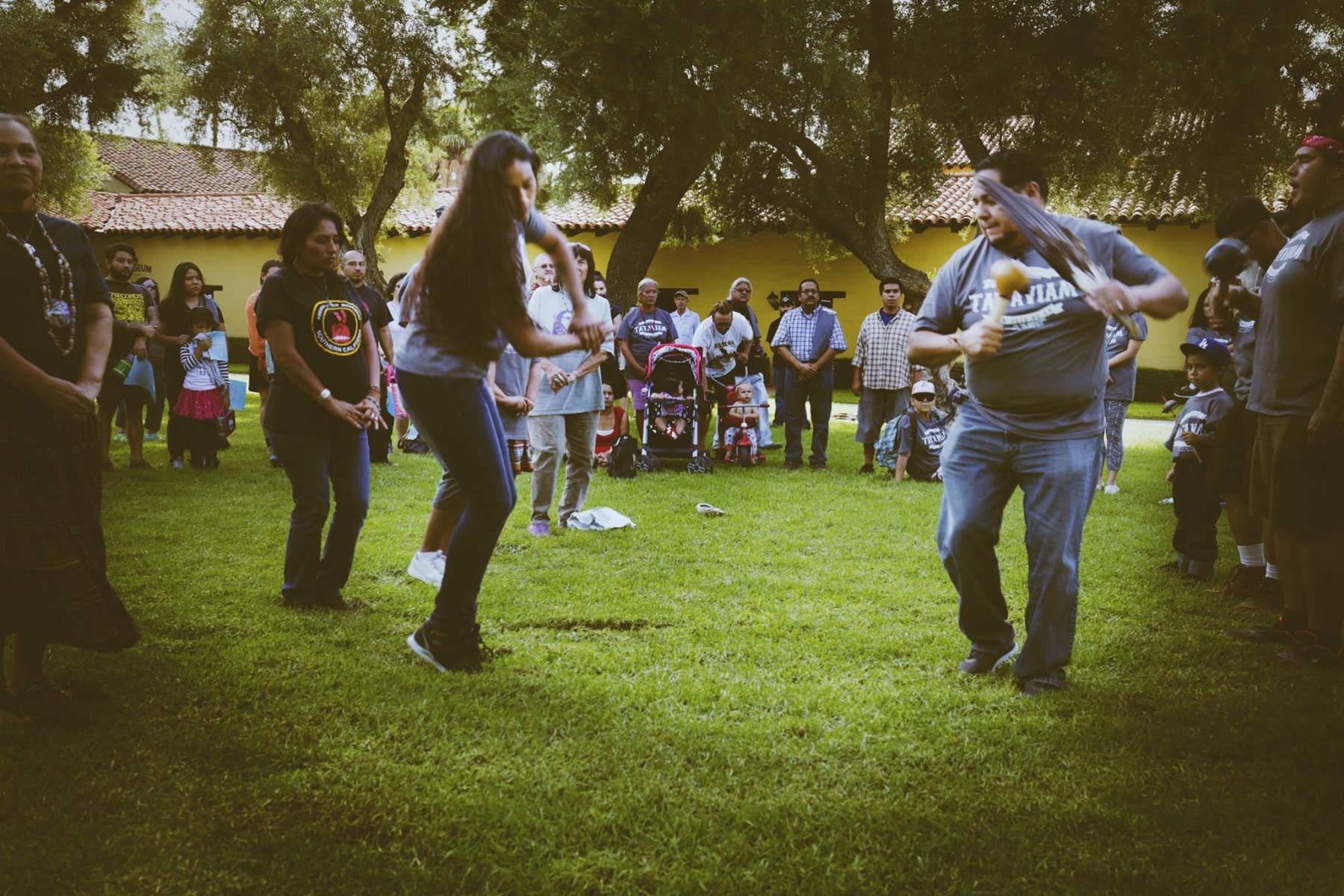
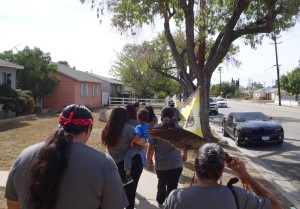
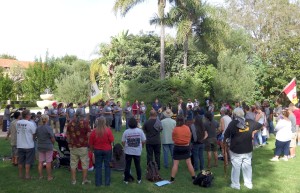
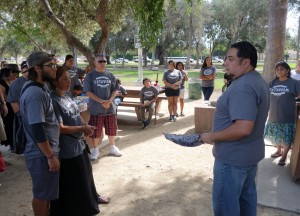
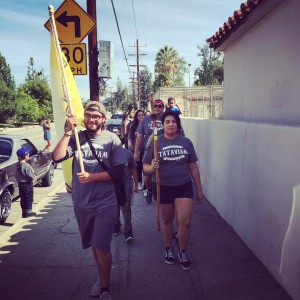
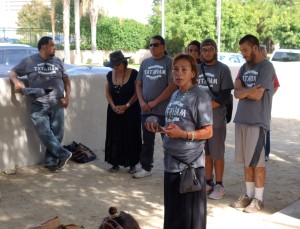
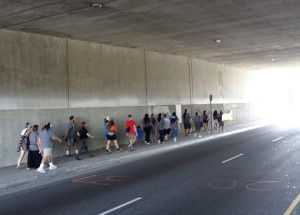
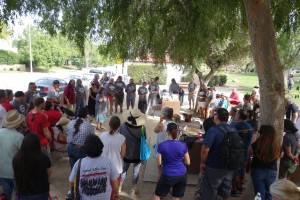
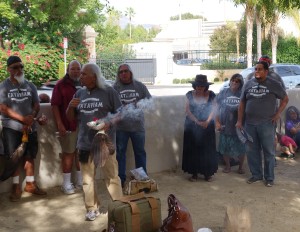
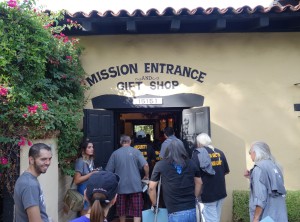
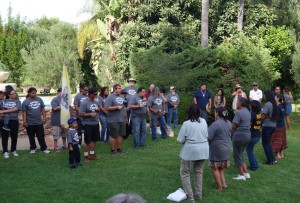
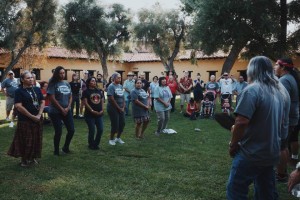
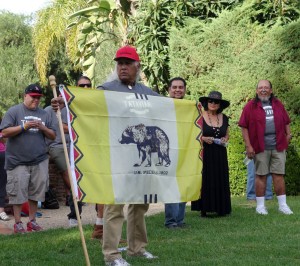
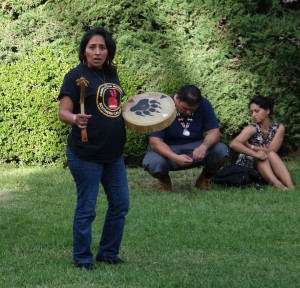
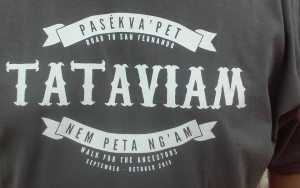
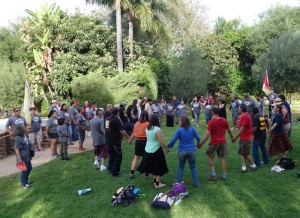
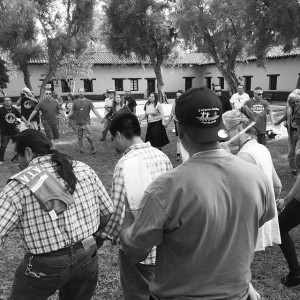
It’s nice to hear about the Tatavium brothers and sisters coming together. I hope to read much more about Tatavium Culture. Thank you
The land of my ancestors. The San Fernando mission and all missions in California for that matter are reminders of sadness, pain, oppression, domination and cruelty that my ancestors endured at the hands of many greedy, soulless non natives who tried to break the spirit of my ancestors… they did not! The thieves stole our land, resources, language and culture but only for a little while. One thing the thieves could never take from my ancestors was spirit. We are still here and the walk for the ancestors 2015 rekindling our pride as first Californian’s nothing, no one can take away our spirit, no one can take away who we are as descendants of the Tataviam
(people who face the sun) Yesterday, today and forever!!
I am writing a paper on how the Native Americans were treated through the Spanish Missions and would like to use this website as a resource. I am looking for who I can quote so I may use this article. Thank you, and I am hopeful that people will actually know the real truth of the history of how the missions were created, how the Native Americans were treated and what took place in the missions. Thank you for your help again.